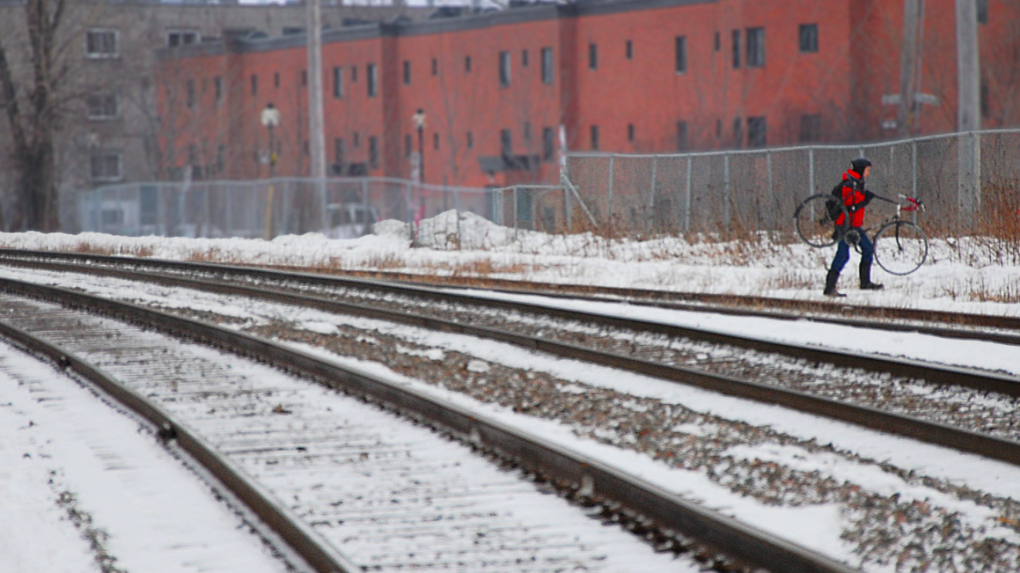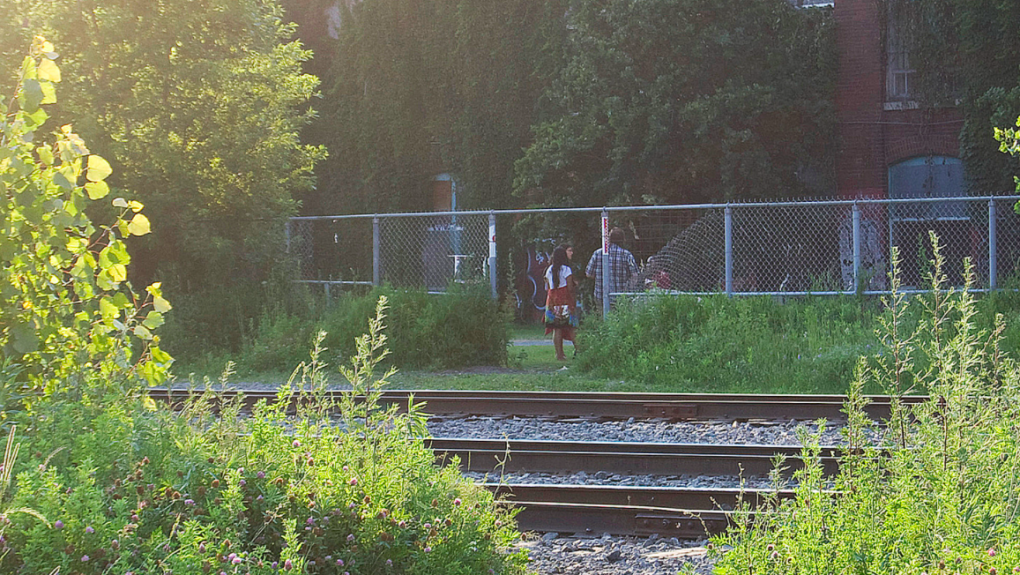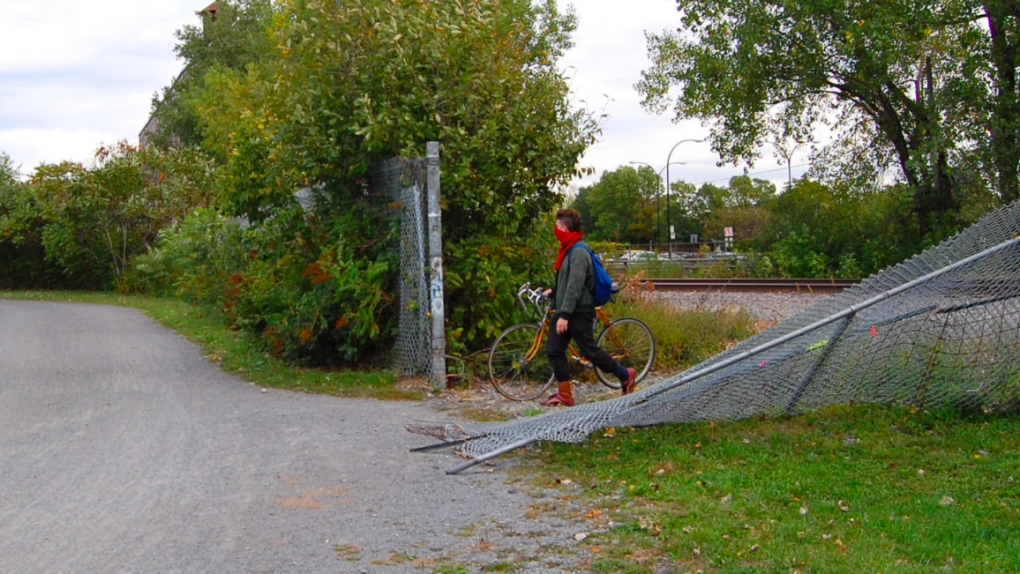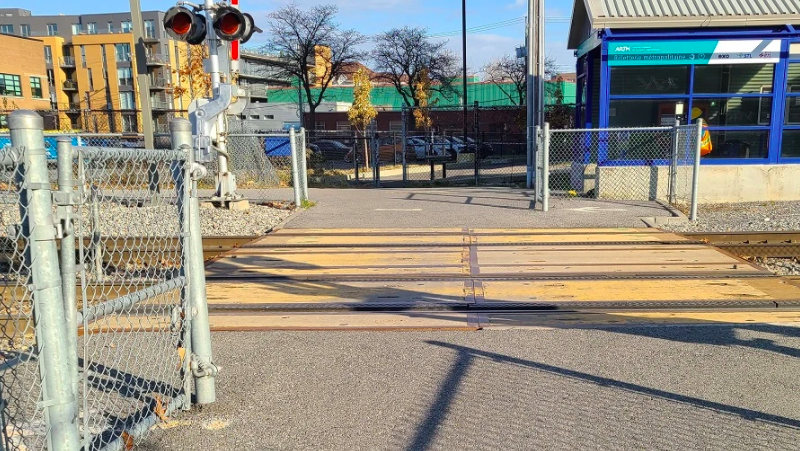Young woman's death on Mile End train tracks brings fresh anger to old stalemate over safe crossing
 A man is photographed crossing the train tracks between Mile End and Rosemont as part of an ongoing art project by Clayton Bailey (Photo: Clayton Bailey)
A man is photographed crossing the train tracks between Mile End and Rosemont as part of an ongoing art project by Clayton Bailey (Photo: Clayton Bailey)
On Feb. 3, a 31-year-old photographer working at a small gallery in Montreal's Mile End headed out on a typical work errand—to make a delivery a few hundred yards away.
She walked north, needing to go from near Van Horne Ave. to the southern edge of Rosemont-Petite-Patrie.
The woman knew the area well, but to get there, she had to duck through a hole in a chain-link fence.
There’s a railway separating the two busy neighbourhoods, with no legal crossing along that 750-metre stretch between St-Laurent Blvd. and St-Denis St.
Instead -- to save the 20 minutes it would take to detour to an underpass -- people walk through the holes frequently torn in the fence and step over the rails.
The tracks are usually quiet. About eight or nine trains run along them per day in winter, according to Canadian Pacific Rail (CP), which owns them. And hundreds of people cross each day.
As the photographer stepped over them that day, however, a train hit her. She died later that day from her injuries, leaving behind family, friends, classmates and colleagues mourning the loss of someone described as quiet but “forceful,” a very talented artist, a deep thinker.
“There are no words to express our pain,” wrote one of her friends, Sarah Poirier, on Facebook, announcing her death.
The woman “was happy, in love, had just submitted her master's thesis and had many plans for exhibitions, trips and so many new memories to create with her friends, family and cats,” Poirier wrote.
The woman’s family asked for her name not to be published online, and her close friends declined to give interviews, saying they’d like her to be publicly remembered for her life and work, not for how she died.
But people across Mile End and Rosemont wrote online that they were shaken not only by the tragedy, but by the mundane reason for it, given how many of them do the exact same thing every day.
A WORST-CASE SCENARIO
The news also shook up those who have spent countless volunteer hours lobbying for a safe crossing at that very spot.
“This poor woman,” said Mistaya Hemingway, a member of a citizens’ group formed at least a dozen years ago to campaign for a crosswalk.
“It just makes me so angry that we always have to get to this place, the loss of a life, for this thing to come up again.”
What may sting even more is that there’s no clear indication yet that anything will, in fact, change. After a binding decision three years ago, there’s been a standstill that has no sign of ending.
A few years ago, “we kind of lost steam,” Hemingway said. “It felt like it had gone as far as we could take it.”
 People gather at a hole in the fence torn by citizens in order to cross the CP train tracks in Mile End, between legal crossings. (Photo: Clayton Bailey)
People gather at a hole in the fence torn by citizens in order to cross the CP train tracks in Mile End, between legal crossings. (Photo: Clayton Bailey)
With legal options exhausted, the city now says it’s trying a new strategy: involving the federal government more heavily.
Following the death, there was a meeting between two relevant boroughs and a head city planner, said a spokesperson for the Montreal mayor’s cabinet, calling the accident "deplorable."
“Following this meeting, discussions were initiated with the federal government to find a lasting solution,” she said, adding that “all efforts are being made” to act “as soon as possible.”
LIMITED OPTIONS, SEEMINGLY SET IN STONE
Technically, however, the city does have the right to build a crossing—just not the kind it wants.
After court appearances and piles of documentation, CP and the city finally made their cases in binding mediation starting in 2017.
The city argued for the right to build a street-level crosswalk over the tracks with a barrier on either side, saying this is the only type of rail crossing that’s easily accessible and affordable.
CP argued that a street-level crossing would interfere too much with its operations and delay its shipments to the Port of Montreal. In particular, it said, it sometimes stored empty rail cars there, and a pedestrian crossing would make it hard to do that.
CP also maintained that it’s too dangerous to allow pedestrians to mix with freight trains, saying that a street-level crosswalk would increase the risk of accidents.
Instead, it suggested, the city could build a raised pedestrian walkway that wouldn’t interfere with the trains’ operation.
 A man is photographed crossing the train tracks between Mile End and Rosemont, through a gap in the fence, as part of an ongoing art project by Clayton Bailey. (Photo: Clayton Bailey)
A man is photographed crossing the train tracks between Mile End and Rosemont, through a gap in the fence, as part of an ongoing art project by Clayton Bailey. (Photo: Clayton Bailey)
In the end, the Canadian Transportation Agency sided with CP in its written decision, saying that while a raised walkway may be much more expensive and harder to build, and though the city may believe it won’t be well used, it’s still an option.
It granted the city the right to build this kind of bridge, and to pay the full costs.
But the issue has been dormant since 2019, and the city has never moved forward with that idea. This month, it repeated that it’s not planning to build elevated walkways in the Plateau or elsewhere.
“These [raised walkway] projects are not part of the City’s short-term planning, due to their complexity and the costs associated with the creation of such infrastructures,” said a spokesperson.
It doesn’t consider the walkways to be “safe, efficient and universally accessible,” the city elaborated in a later statement.
It has some experience with the idea. In Parc-Ex, there used to be a raised footbridge allowing people to get to Jarry Park over the tracks that run along the park's western edge. But that was closed in 2007 and later demolished after safety problems tied to the nearby elementary school.
Locals also told CTV News that it wasn't well used and people would still sneak across the tracks. A level crossing, with bells and safety barriers, was put in its place in the park. A similar one was just built two months ago at the Parc-Ex train station, with the CTA's permission.
 The new Gare du Parc pedestrian rail crossing in Parc-Extension, as shown in a release from the city in fall 2021 (Photo: City of Montreal)
The new Gare du Parc pedestrian rail crossing in Parc-Extension, as shown in a release from the city in fall 2021 (Photo: City of Montreal)
CP, however, maintains that the ball is now in the city’s court in Mile End, and in the meantime, people trespass at their own risk.
“Trespassing on railway property is both dangerous and illegal,” wrote CP spokesperson Stacy Patenaude. She also quoted from the 2019 decision, saying the city has the right to build.
CP’s reasoning rankles many locals who follow the issue—that a crossing would add some time to their freight trips.
“No one is powerful enough to make them do anything, except maybe a lot of citizen pressure,” said Hemingway. “They don't want to slow those trains down.”
But many people don't know the city now has the right to build there, either, including some who follow the issue the most closely.
Clayton Bailey, who has photographed people's crossings in Mile End for years as part of an art project, said he wasn't aware of that part of the 2019 decision. Maybe a compromise is better than nothing, some of the victim's friends suggested.
TRAINS WILL SLOW IN THAT SPOT UNDER NEW ORDER
Despite saying talks were restarting, the city didn’t specify which federal partners it was working with in the new push for a street-level crossing.
Transport Canada told CTV News that it issued an order to CP and the city the same day of the woman’s death, but it didn’t suggest it was reopening the crossing debate.
It ordered CP to reduce trains’ speed in the Rosemont-Plateau area, to ring locomotive bells during daylight hours to warn trespassers, and to have more regular patrols and inspections of the fencing.
But the CTA is the only body that can authorize rail crossings, Transport said. When asked about its 2019 judgment, which the city considers a no-go, the CTA said “we do not comment on our decisions as they speak for themselves.”
‘THEY CAN BE PRETTY QUIET’
In the meantime, Hemingway says modern generations need to re-learn train safety, given that in some areas their lives are so intertwined with the tracks, with no protection.
“Trains are dangerous, 100 per cent,” she said. “They can be pretty quiet… And some of them, when they don't have a huge heavy cargo, they can move pretty quick – quicker than you think.”
In the end, however, the tragedy this month was a “totally preventable” failure of planning, she said.
“When they built those rain tracks, there were fields on either side,” she said. “All levels of government have a responsibility for this infrastructure.”
CTVNews.ca Top Stories

Quebec nurse had to clean up after husband's death in Montreal hospital
On a night she should have been mourning, a nurse from Quebec's Laurentians region says she was forced to clean up her husband after he died at a hospital in Montreal.
'Anything to win': Trudeau says as Poilievre defends meeting protesters
Prime Minister Justin Trudeau is accusing Conservative Leader Pierre Poilievre of welcoming 'the support of conspiracy theorists and extremists,' after the Conservative leader was photographed meeting with protesters, which his office has defended.
'My stomach dropped': Winnipeg man speaks out after being criminally harassed following single online date
A Winnipeg man said a single date gone wrong led to years of criminal harassment, false arrests, stress and depression.
What is changing about Canada's capital gains tax and how does it impact me?
The federal government's proposed change to capital gains taxation is expected to increase taxes on investments and mainly affect wealthy Canadians and businesses. Here's what you need to know about the move.
Bank of Canada officials split on when to start cutting interest rates
Members of the Bank of Canada's governing council were split on how long the central bank should wait before it starts cutting interest rates when they met earlier this month.
Something in the water? Canadian family latest to spot elusive 'Loch Ness Monster'
For centuries, people have wondered what, if anything, might be lurking beneath the surface of Loch Ness in Scotland. When Canadian couple Parry Malm and Shannon Wiseman visited the Scottish highlands earlier this month with their two children, they didn’t expect to become part of the mystery.
Pilot reported fire onboard plane carrying fuel, attempted to return to Fairbanks just before crash
One of the two pilots aboard an airplane carrying fuel reported there was a fire on the airplane shortly before it crashed and burned outside Fairbanks, killing both people on board, a federal aviation official said Wednesday.
Police tangle with students in Texas and California as wave of campus protest against Gaza war grows
Police tangled with student demonstrators in Texas and California while new encampments sprouted Wednesday at Harvard and other colleges as school leaders sought ways to defuse a growing wave of pro-Palestinian protests.
'One of the single most terrifying things ever': Ontario couple among passengers on sinking tour boat in Dominican Republic
A Toronto couple are speaking out about their 'extremely dangerous' experience on board a sinking tour boat in the Dominican Republic last week.































